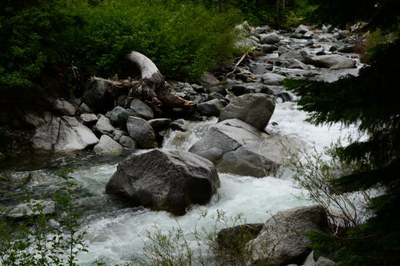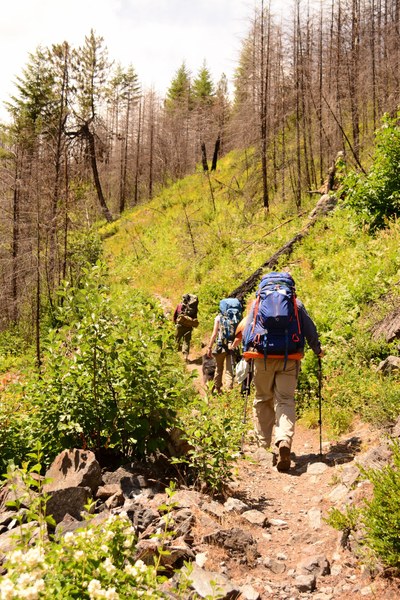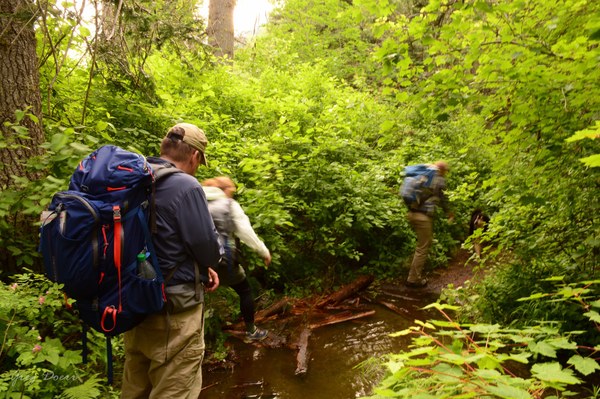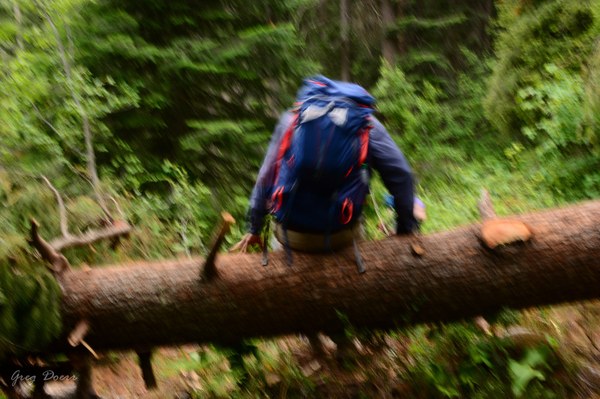
Trip Report
Backpack - Ingalls Creek
This was a good early-season trip for B3 students and a good warm-up for other backpackers.
- Fri, Jun 17, 2016 — Sat, Jun 18, 2016
- Backpack - Ingalls Creek
- Ingalls Creek
- Backpacking
- Successful
-

- Road suitable for all vehicles
-
The trail was well maintained for the first 3.5+ miles, with only minor stream crossings and short sections of overgrowth.

Not a lot of dramatic scenery, but ample forest to appreciate (with occasional viewpoints). Between 3.5 and 5 miles, we ran into wide stream crossings, multiple large logs crossing the trail (that had to be climbed over, not stepped over), and extended sections of bushwhacking. Full-length pants and long sleeves are a must; gaiters and snow-sealed boots would be strongly recommended. The trail was recognizable through the brush, but travel was slow – 1/2 to 2/3 of our regular pace.

We passed multiple campsites that were large enough for 2-3 tents, but had little or no room to cook or hang food away from the tents (both important for this area, which hosts ticks, mosquitos, snafflehounds, and rattlesnakes – none of which we had problems with). We camped at a cross-country site about 300 ft. south of (and not visible from) the trail, next to Ingalls Creek. This “site” was large (for dense forest) – with enough room to spread out tents and keep cooking and food storage separate. The main challenge was hanging food – tree branches were thin, requiring each sack to be hung on a different tree and relatively close to the trunk.

Overall, a good route for a B3 or similar backpack.
We hiked about four miles from the Ingalls Creek Trailhead toward Falls Creek. At this point, one of the participants and I turned back about one-half mile to check out a campsite he had previously used, south of the trail and immediately next to Ingalls [River]. We hiked cross-country about 300ft. (it seemed like about a quarter mile) and found the campsite. In spite of its being invisible from the trail, there was ample evidence that someone with little or no appreciation of Leave No Trace had camped there before. The rest of the group, including the trip leader, arrived shortly thereafter and looked over the site.
After brief discussion, we decided to camp at this location (vs. along the trail near Falls Creek) – contingent on making a special point of not leaving a trace. Since this was a B3 backpacking trip with two novice backpackers, we recognized that this would be both a small challenge and an excellent demonstrating and learning opportunity. We set up camp, stowed our overnight gear, and returned to the trail to hike further toward Falls Creek. (Since rain was forecast for Saturday, we knew that Friday was our chance to hike further.) This turned out to also be a good opportunity to explain to the novices that even when going for four mile round-trip hike from a campsite, it is important to bring the 10 essential systems.
Starting within a quarter mile of the campsite turnoff, we encountered significant and prolonged trail obstructions – fallen logs, overgrowth, and swollen streams. We continued for about one and one-half miles, before the trip leader and I decided to turn back so that we could cook before it got dark and started raining.
Saturday morning, we got up gradually – precisely in order of experience (the most experienced first). Since it was raining, most group members – myself included – opted to eat a quick breakfast snack, in lieu of cooking in the rain. After packing up (doing what we could to keep our gear from getting soaked), we headed straight for the trailhead, only making brief stops to snack, make gear adjustments, or look at plants.
 Gregor Doerr
Gregor Doerr